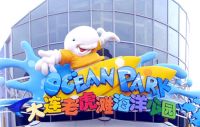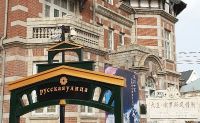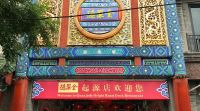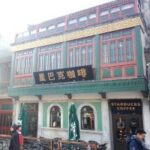Mao proclaimed the “New China” in 1949 from the gate of Tiananmen, a China free of imperialism and one that would reclaim its role as a great power and a leader in promoting peace and stability. They’re still the themes of the current regime.
It occurred to me when I returned to Beijing that I’m witnessing, as well, the “New New China,” in the big cities anyway, prosperous, modern, integrated into the world economy—and full of a middle class that understands consumerism!
I saw both in Dalian. As I identified yesterday, the city was born of the ambitions of the Russians and the Japanese, who fought a major war on Chinese territory for Chinese territory—without resistance from the Chinese, who’d lost the right when they lost the war against Japan in 1895. Japan wanted the resources Manchuria held; Russia wanted to compensate for a “mistake” it made when it reached the Pacific. Unlike the U.S., which found San Diego, L.A., San Francisco, and Seattle had harbors, Russia had Vladivostok, which froze in the winter. In addition, by its borders with China, Russian contact with its Far East had to go around the long Amur—I prefer the Chinese name, Black Dragon River—bend. Hence, Russia cut straight across with the trans Siberian/Chinese Eastern Railroad, then dropped a railroad to Dalian from Harbin, a city still with some marvelous Russian buildings. In fact, Stalin tried to get the Chinese to cede Russia the use and possession of Dalian into the 1950s (Sino Soviet friendship indeed!). The Japanese, who took the Liaodong Peninsula, which included Dalian, from the Russians, with the consent of the United States (Roosevelt won a Peace Prize!) made it the headquarters of the Kwantung Leased Territory, run by those generals who gave us World War II in the Pacific. It was the location of the railway headquarters too, that helped drain the resources—coal and iron—that helped make Japan one of the great powers. As I recall, Japan kept the Kwantung Leased Territory as a possession into World War II. I know I have Japanese stamps used in Dalian through at least the 1930s.
The “new new” China was also on display. June 1 is celebrated in China as  International Children’s Day. Given the One Child Policy, there were a lot of “little emperors” yesterday, in their finest clothes, usually with their grandparents, everywhere. In the morning, my guide took me to Ocean Park, a seaside park/aquarium that features several shows. In line with the new Russian theme (the languages are Japanese, Russian, and Chinese—much less English than elsewhere; I was easy to spot as the guy from out of town in the park), during the busy months there are Russian dancers, “beautiful blonde ladies with long legs,” my female(!) guide intoned. There’s a Russian street which has some old
International Children’s Day. Given the One Child Policy, there were a lot of “little emperors” yesterday, in their finest clothes, usually with their grandparents, everywhere. In the morning, my guide took me to Ocean Park, a seaside park/aquarium that features several shows. In line with the new Russian theme (the languages are Japanese, Russian, and Chinese—much less English than elsewhere; I was easy to spot as the guy from out of town in the park), during the busy months there are Russian dancers, “beautiful blonde ladies with long legs,” my female(!) guide intoned. There’s a Russian street which has some old  Russian buildings (one, an “Arbat” restaurant, reminded me of a similar street in Moscow, where similar goods are sold—the matryoshka dolls, Soviet-military things, binoculars, etc.) I had a guide once in Beijing who took us to the Russian market, where mafiosa-looking people came and loaded suitcases with goods to sell in Russia. “Is this a good place to shop, ” I asked her. “Not good enough for Chinese,” she
Russian buildings (one, an “Arbat” restaurant, reminded me of a similar street in Moscow, where similar goods are sold—the matryoshka dolls, Soviet-military things, binoculars, etc.) I had a guide once in Beijing who took us to the Russian market, where mafiosa-looking people came and loaded suitcases with goods to sell in Russia. “Is this a good place to shop, ” I asked her. “Not good enough for Chinese,” she

sniffed. And there is a Japanese street too, and more Japanese buildings left (the police station is now a Citibank), but the Japanese rule lasted from 1905 through 1945. And Dalian has a street I call Michigan Avenue, like so many of the big Chinese cities, with world-class brands (the real ones; the copies are a block away)

When I got back to Beijing, I headed for Dashalar, a street I remembered fondly for its small shops, in front of the Arrow Gate to the Forbidden City. It was close enough to walk. I remembered vaguely construction the last time I was there, and what had happened is that the area had gotten a complete makeover, made to look old and traditional—kind of forced, I thought. Next to the shops with the traditional brands (many of them from the vilified 19th century Qing Dynasty) from Beijing and elsewhere (a silk shop from the 1700s, sauces since 1871, etc.) in made-to-look traditional shops, were the Starbucks and the Armanis. The  toilets were real (only the
toilets were real (only the  handicapped stalls or senior stalls have western sit-downers; and in any case bring your own papers), and so were the restaurants. The choice of a “last supper” was easy: Roast Duck at a place that had the fewest foreigners!
handicapped stalls or senior stalls have western sit-downers; and in any case bring your own papers), and so were the restaurants. The choice of a “last supper” was easy: Roast Duck at a place that had the fewest foreigners!
I walked down the back streets until I reached an area where the old shops were not “olde shoppes” to remind me that I was in China.
I leave the hotel in 7 hours, and I am hoping to get some last sightseeing in. My goal is the National Museum; I’ve not been there for years (it was often closed), and I understand a 2008 renovation tripled the size. The number of tickets is limited so I’ll probably stand in line after breakfast until the place opens in hopes of getting one. In line with the New New China, a special exhibit is on Louis Vuitton! I like my irony delicious.